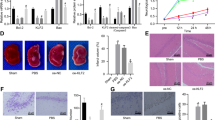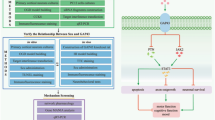Abstract
Ectodermal-neural cortex 1 (Enc1), a member of the KELCH family, is widely expressed in the nervous system and plays an important role in nervous system development. However, the function of Enc1 in neural survival following apoptosis induced by hypoxia and hypoglycemia remains unclear. In this study, we aimed to investigate the role of Enc1 in the cell survival of neurons subjected to apoptosis induced by oxygen–glucose deprivation (OGD) and the potential underlying mechanism. The in vitro cell model of neuron OGD was established by anoxia/hypoglycemic injury. Real-time quantitative PCR and Western blot analyses showed that Enc1 was significantly reduced in neurons under anoxia/hypoglycemic injury. Knockdown of Enc1 by small interfering RNA markedly promoted the survival of neurons under anoxia/hypoglycemia. Moreover, knockdown of Enc1 inhibited neuronal apoptosis. Conversely, overexpression of Enc1 showed the opposite effect. Further, data demonstrated that Enc1 might regulate neuron survival through heme oxygenase-1 (HO-1) and nuclear factor erythroid 2-related factor (Nrf2). Taken together, our study suggests that knockdown of Enc1 protects newborn neurons from apoptosis induced by OGD associated with Nrf2 and HO-1, providing a novel molecular target for the treatment of neonatal apoptosis induced by hypoxia and hypoglycemia brain injury.








Similar content being viewed by others
Abbreviations
- Enc1:
-
Ectodermal-neural cortex 1
- HO-1:
-
Heme oxygenase-1
- Nrf2:
-
Nuclear factor erythroid 2-related factor
- MTT:
-
3-(4,5-Dimethylthiazol-2-yl)-2,5-diphenyltetrazolium bromide
- TBS:
-
Tris-buffered saline
- RNAi:
-
RNA interference
- siRNA:
-
Small interference RNA
- ARE:
-
Antioxidant responsive element
References
Barbagallo I, Galvano F, Frigiola A, et al. (2013) Potential therapeutic effects of natural heme oxygenase-1 inducers in cardiovascular diseases. Antioxid Redox Signal 18:507–521
Bindu S, Mazumder S, Dey S, et al. (2013) Nonsteroidal anti-inflammatory drug induces proinflammatory damage in gastric mucosa through NF-kappaB activation and neutrophil infiltration: anti-inflammatory role of heme oxygenase-1 against nonsteroidal anti-inflammatory drug. Free Radic Biol Med 65:456–467
Cheng CF, Lian WS, Chen SH, et al. (2012) Protective effects of adiponectin against renal ischemia-reperfusion injury via prostacyclin-PPARalpha-heme oxygenase-1 signaling pathway. J Cell Physiol 227:239–249
Dhanoa BS, Cogliati T, Satish AG, Bruford EA, Friedman JS (2013) Update on the Kelch-like (KLHL) gene family. Hum Genomics. 7:13
Du X, Xu H, Jiang H, Xie J (2013) Akt/Nrf2 activated upregulation of heme oxygenase-1 involves in the role of Rg1 against ferrous iron-induced neurotoxicity in SK-N-SH cells. Neurotox Res 24:71–79
Dulak J, Jozkowicz A (2014) Novel faces of heme oxygenase-1: mechanisms and therapeutic potentials. Antioxid Redox Signal 20:1673–1676
Feiner N, Murakami Y, Breithut L, Mazan S, Meyer A, Kuraku S (2013) Saltatory evolution of the ectodermal neural cortex gene family at the vertebrate origin. Genome Biol Evol 5:1485–1502
Fujita M, Furukawa Y, Tsunoda T, Tanaka T, Ogawa M, Nakamura Y (2001) Up-regulation of the ectodermal-neural cortex 1 (ENC1) gene, a downstream target of the beta-catenin/T-cell factor complex, in colorectal carcinomas. Cancer Res 61:7722–7726
Hernandez MC, Andres-Barquin PJ, Holt I, Israel MA (1998) Cloning of human ENC-1 and evaluation of its expression and regulation in nervous system tumors. Exp Cell Res 242:470–477
Hull TD, Kamal AI, Boddu R, et al. (2015) Heme oxygenase-1 regulates myeloid cell trafficking in AKI. J Am Soc Nephrol 26:2139–2151
Hwa JS, Jin YC, Lee YS, et al. (2012) 2-Methoxycinnamaldehyde from Cinnamomum cassia reduces rat myocardial ischemia and reperfusion injury in vivo due to HO-1 induction. J Ethnopharmacol 139:605–615
Inaba M, Sugioka K, Naruko T, et al. (2014) Enhanced expression of hemoglobin scavenger receptor and heme oxygenase-1 is associated with aortic valve stenosis in patients undergoing hemodialysis. Hemodial Int 18:632–640
Ishii T, Itoh K, Takahashi S, et al. (2000) Transcription factor Nrf2 coordinately regulates a group of oxidative stress-inducible genes in macrophages. J Biol Chem 275:16023–16029
Kim TA, Ota S, Jiang S, Pasztor LM, White RA, Avraham S (2000) Genomic organization, chromosomal localization and regulation of expression of the neuronal nuclear matrix protein NRP/B in human brain tumors. Gene 255:105–116
Le WD, Xie WJ, Appel SH (1999) Protective role of heme oxygenase-1 in oxidative stress-induced neuronal injury. J Neurosci Res 56:652–658
Liang XQ, Avraham HK, Jiang S, Avraham S (2004) Genetic alterations of the NRP/B gene are associated with human brain tumors. Oncogene 23:5890–5900
Niatsetskaya ZV, Sosunov SA, Matsiukevich D, et al. (2012) The oxygen free radicals originating from mitochondrial complex I contribute to oxidative brain injury following hypoxia-ischemia in neonatal mice. J Neurosci 32:3235–3244
Nimura T, Weinstein PR, Massa SM, Panter S, Sharp FR (1996) Heme oxygenase-1 (HO-1) protein induction in rat brain following focal ischemia. Brain Res Mol Brain Res 37:201–208
O’Malley SS, Wu R, Mayne ST, Jatlow PI (2014) Smoking cessation is followed by increases in serum bilirubin, an endogenous antioxidant associated with lower risk of lung cancer and cardiovascular disease. Nicotine Tob Res 16:1145–1149
Panahian N, Yoshiura M, Maines MD (1999) Overexpression of heme oxygenase-1 is neuroprotective in a model of permanent middle cerebral artery occlusion in transgenic mice. J Neurochem 72:1187–1203
Peng B, Zhao P, Lu YP, et al. (2013) Z-ligustilide activates the Nrf2/HO-1 pathway and protects against cerebral ischemia-reperfusion injury in vivo and in vitro. Brain Res 1520:168–177
Sanderson TH, Reynolds CA, Kumar R, Przyklenk K, Huttemann M (2013) Molecular mechanisms of ischemia-reperfusion injury in brain: pivotal role of the mitochondrial membrane potential in reactive oxygen species generation. Mol Neurobiol 47:9–23
Scannevin RH, Chollate S, Jung MY, et al. (2012) Fumarates promote cytoprotection of central nervous system cells against oxidative stress via the nuclear factor (erythroid-derived 2)-like 2 pathway. J Pharmacol Exp Ther 341:274–284
Tam EW, Haeusslein LA, Bonifacio SL, et al. (2012) Hypoglycemia is associated with increased risk for brain injury and adverse neurodevelopmental outcome in neonates at risk for encephalopathy. J Pediatr 161:88–93
Tao J, Liu W, Shang G, et al. (2015) MiR-207/352 regulate lysosomal-associated membrane proteins and enzymes following ischemic stroke. Neuroscience 305:1–14
Tsuji G, Takahara M, Uchi H, et al. (2012) Identification of ketoconazole as an AhR-Nrf2 activator in cultured human keratinocytes: the basis of its anti-inflammatory effect. J Invest Dermatol 132:59–68
van Muiswinkel FL, Kuiperij HB (2005) The Nrf2-ARE signalling pathway: promising drug target to combat oxidative stress in neurodegenerative disorders. Curr Drug Targets CNS Neurol Disord 4:267–281
von Bulow M, Heid H, Hess H, Franke WW (1995) Molecular nature of calicin, a major basic protein of the mammalian sperm head cytoskeleton. Exp Cell Res 219:407–413
Wang XJ, Zhang DD (2009) Ectodermal-neural cortex 1 down-regulates Nrf2 at the translational level. PLoS ONE 4:e5492
Wu CC, Huang YS, Chen JS, et al. (2015) Resveratrol ameliorates renal damage, increases expression of heme oxygenase-1, and has anti-complement, anti-oxidative, and anti-apoptotic effects in a murine model of membranous nephropathy. PLoS ONE 10:e0125726
Yeh YH, Kuo CT, Chang GJ, et al. (2015) Rosuvastatin suppresses atrial tachycardia-induced cellular remodeling via Akt/Nrf2/heme oxygenase-1 pathway. J Mol Cell Cardiol 82:84–92
Author information
Authors and Affiliations
Corresponding author
Ethics declarations
The animal procedures were performed according to the guidelines of the Institutional Animal Care and Use Committee of Xi’an Jiaotong University.
Conflict of Interest
The authors declare that they have no conflicts of interest. The authors alone are responsible for the content.
Rights and permissions
About this article
Cite this article
Lei, H., Li, J., Zhao, Z. et al. Inhibition of Ectodermal-Neural Cortex 1 Protects Neural Cells from Apoptosis Induced by Hypoxia and Hypoglycemia. J Mol Neurosci 59, 126–134 (2016). https://doi.org/10.1007/s12031-016-0742-7
Received:
Accepted:
Published:
Issue Date:
DOI: https://doi.org/10.1007/s12031-016-0742-7




